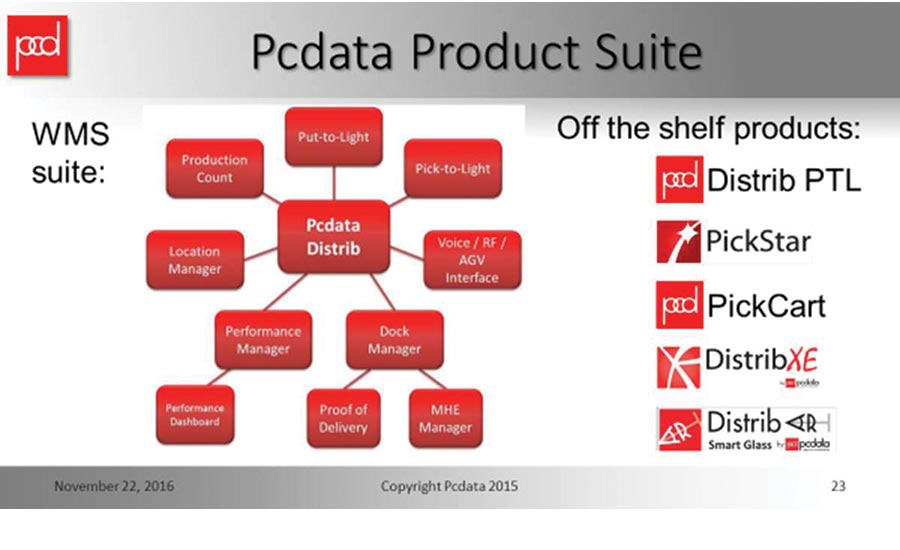Inventory control focuses on sustainability, going paperless
Modern-day inventory control concentrates on going paperless and increasing sustainability

courtesy of Pcdata

courtesy of FlexiBake

courtesy of SICK

courtesy of Toolbox Software

courtesy of HighJump Software

courtesy of FlexiBake






Inventory control is an important part of a supplier’s day-to-day operations for snack production and bakeries. If a company’s inventory control is not effective, product production could be delayed, causing the company to lose both time and profit. In 2017, inventory control is all about efficiency, and the best and easiest ways of improving the process.
Going paperless
“The benefits of going paperless are endless,” says Wayne Ortner, product advisor, FlexiBake, Vancouver, British Columbia.
Sustainability plays a big factor in why companies are choosing to forego paper. “Sustainability is an initiative that every company should be pursuing, and the benefits can be more than one would expect. Having the newest sustainable technologies, such as going paperless, attracts new talent and keeps current employees engaged,” adds Ortner.
“Going paperless will improve accuracy and efficiency,” comments Mark Braun, president, North American operations, Pcdata, East Granby, CT. “Using technology to process orders saves time in preparation of the paperwork, and allows the operators to pick the orders faster, and more accurately, as well. Throughout the order fulfillment process, paperless dispatch records every step.”
Customers also benefit from going paperless. “By going paperless, any customer inquiry is managed easily with point-and-click searching for the wholesaler, but there are customer-side benefits, as well, if done properly,” notes Derek Curtis, vice president, sales, HighJump Software, Minneapolis. “A paperless solution that merely relies on emailing of PDFs or other electronic documents should merely be the baseline.”
Inefficiency can be kept to a minimum by going paperless, as well. “Paperless processes eliminate inefficiencies in material and finished goods distribution on a number of levels,” says John Ashodian, logistics automation marketing manager, SICK, Minneapolis. “By automating the processes by which items flow through the supply chain, errors in handling can be eliminated, goods flow quicker, and information about the status of goods in transit is more readily available.”
Another benefit of going paperless is that critical company data is collected into one place for decision-makers to act on. “Quality control managers can now view real-time reports that accurately reflect the current environment in a production area and proactively improve a failing process before it affects the entire plant, or causes customer service issues downstream,” explains Paula Peterson, supply chain solutions consultant, Lowry Solutions, Brighton, MI. “Manufacturing processes or warehouse inventory movement information are electronically captured right as the work is being performed, and without the potential for transcription errors with paper logs.”
Solutions for effective control
Lowry Solutions’ Packaging Execution System (PES) aims to automate, simplify, and centralize packaging line processes. The equipment provides one point of control during a line changeover by communicating with all equipment that is connected to the line. This helps eliminate many common sources of errors.
“The PES module offers changeover automation, streamlined enterprise labeling, and materials tracking to the lot level,” says Peterson. “About 20 percent of recalls are due to packaging and labeling errors; PES can eliminate these by ensuring that operators confirm a match for raw materials, food contact materials, labeling and packaging before beginning the manufacturing or processing process.”
At Toolbox Software, Scottsdale, AZ, it’s easy to receive and interpret information about order quantities. “Pick-By-Light is still the preferred picking method for fresh bread and buns,” comments Ralf Ulmer, president. “Whereas in the past, descriptions and order quantities were printed on picking sheets, this information is now received electronically by dispotool from the bakery’s ERP system. Dispotool consists of fixed terminals or mobile devices where the staff calls up the products (or customers) to be dispatched.”
Toolbox Software’s ROI is typically 28 months or less, with a great demand popping up for its systems in the last few years. “Today, most of the leading fresh bread and bun bakeries in the U.S. run our systems day to day, such as Aunt Millie’s, Gold Medal Bakery, Lewis Bakeries, Nickles Bakery and Pepperidge Farm, to name a few,” continues Ulmer.
Pcdata recently released the newest version of inventory manager, a solution which allows for the efficient receipt, storage and retrieval of longer code items.
“Inventory manager was designed specifically with snacks and other longer shelf-life items in mind,” adds Braun. “All of our software is developed in-house, with the core being called ‘Distrib,’ short for distribution. Any number of modules can be attached to the Distrib core to provide the complete solution for which the manufacturer or distributor of the products is looking to use.”
FlexiBake takes it a step further: With its software solution, the customer is able to have a live inventory of products, works-in-progress, and raw materials. Purchase orders are created through minimum stock levels, forecasts and historical sales, to make sure that there’s always enough inventory to satisfy production requirements.
“With FlexiBake’s Stores (Freezer) module, manufacturers are able to create a virtual replica of their storage areas. Coupled with the Multiple Warehouses module, manufacturers can track and transfer inventory between remote warehouses and manage multiple storage areas at each,” says Ortner. “Product and raw materials can be palletized and stored at pre-specified locations, or FlexiBake can suggest a location where similar product is already located.”
The warehouse is one of the last areas in the bakery where savings and improvements are possible, notes Ulmer.
Keeping it fresh
A large part of inventory control is making sure that ingredients and packaging materials are currently in stock—and when they should be reordered, either manually, automatically (based on current orders), or predictively, based on typical annual orders for a given time of the year or month. This is a capability that has been built into many software inventory tracking programs.
Lowry Solutions’ Inventory Control system module is an electronic data collection system that automates and streamlines the movement of raw materials and finished goods along the supply chain. It allows operators in manufacturing, packaging, or the warehouse to access critical information stored in business systems, like ERP or MES, using wireless mobile devices which scan barcodes to capture this information, instead of employees manually filling in logs.
“The system prints labels in real-time based on data in a company’s business system for receiving, finished goods, and shipping compliance labels, which eliminates the costs and errors associated with pre-printing labels,” says Peterson.
The system also automatically enforces inventory control methods such as FIFO and LIFO, with FIFO being critical in the food industry to ensure that the oldest inventory is shipped out first. This reduces out-of-date inventory and shrink. Lowry’s ROI is usually less than two years for a real-time inventory control project.
HighJump Software strives to manage by exceptions, as well as sense market demand. “We alert field sales of quantity threshold deals, the minimum quantity to buy, or similar promotions, to avoid inefficient order quantities being processed through the warehouse,” remarks Curtis. “Predictive ordering logic, and suggested placements (SKU and/or quantity) ensure that the waste associated with overloading a truck or store shelf is minimized, allowing our customers to maximize profitability while maintaining a high level of customer service.”
FlexiBake offers many essential tools to manage inventory, track lot numbers, and overcome obstacles typically found during production. Currently, the company offers 14 modules, with more to be released throughout 2017.
“When producing fresh product, manufacturers rely heavily on forecasts to ensure their raw materials on hand keep up with sales and production demands,” comments Ortner. “With FlexiBake’s Online Ordering Portal, you can easily manage your production to satisfy next-day deliveries. Route documentation and packing information can be generated in bulk for all routes, further saving time and energy in the delivery process.”
SICK’s bar code scanners help to automate inventory management for tracking ingredients or packaging materials used in food product and distribution.
“Just as finished goods can be traced throughout the supply chain using automatic identification methods like bar code and RFID, the resources used in the production of goods can also be identified, inventoried and traced by using individual or case load identifiers,” explains Ashodian. “SICK’s wide array of automatic identification solutions, combined with new software analytics and intelligent sensing solutions for validation and inspection, make visibility and control of nearly every facet of inventory management and production possible.”
Looking for a reprint of this article?
From high-res PDFs to custom plaques, order your copy today!











